Rising Vehicle Production
The automotive door-seal market experiences growth driven by the increasing production of vehicles in the US. As manufacturers ramp up output to meet consumer demand, the need for high-quality door seals becomes paramount. In 2025, the US automotive industry is projected to produce approximately 12 million vehicles, which translates to a significant demand for door seals. These components are essential for ensuring vehicle integrity, noise reduction, and thermal insulation. Consequently, the automotive door-seal market is likely to benefit from this surge in production, as manufacturers seek reliable suppliers to meet their needs. Furthermore, the trend towards electric vehicles (EVs) is expected to further stimulate demand, as these vehicles often require specialized sealing solutions to enhance energy efficiency and performance.
Growth of Aftermarket Services
The automotive door-seal market is benefiting from the growth of aftermarket services, as vehicle owners increasingly seek to maintain and enhance their vehicles' performance. The aftermarket segment is projected to grow at a CAGR of 5% through 2025, driven by rising vehicle ownership and the desire for customization. Door seals, being critical components for vehicle maintenance, are often replaced to improve insulation and reduce noise. This trend presents a lucrative opportunity for the automotive door-seal market, as manufacturers and suppliers can capitalize on the increasing demand for replacement parts. Additionally, the rise of e-commerce platforms facilitates easier access to these components, further driving market growth.
Stringent Regulatory Standards
The automotive door-seal market is influenced by the implementation of stringent regulatory standards aimed at improving vehicle safety and environmental performance. In the US, regulations concerning emissions and safety have become increasingly rigorous, compelling manufacturers to adopt advanced sealing technologies. For instance, the National Highway Traffic Safety Administration (NHTSA) has established guidelines that necessitate the use of high-performance door seals to prevent water ingress and enhance passenger safety. As a result, the automotive door-seal market is likely to see a shift towards innovative materials and designs that comply with these regulations. This trend not only ensures compliance but also enhances the overall quality and durability of vehicles, thereby driving market growth.
Consumer Demand for Enhanced Comfort
The automotive door-seal market is increasingly driven by consumer demand for enhanced comfort and luxury in vehicles. As consumers become more discerning, they expect vehicles to provide superior acoustic insulation and climate control. High-quality door seals play a crucial role in achieving these expectations by minimizing noise intrusion and preventing air leaks. In 2025, Market Research Future indicates that approximately 70% of consumers prioritize comfort features when purchasing a vehicle, which directly influences manufacturers to invest in advanced sealing technologies. Consequently, the automotive door-seal market is likely to see a surge in demand for innovative sealing solutions that cater to these consumer preferences, ultimately enhancing the overall driving experience.
Technological Advancements in Manufacturing
Technological advancements in manufacturing processes are significantly impacting the automotive door-seal market. Innovations such as automation, 3D printing, and advanced materials are enabling manufacturers to produce door seals with enhanced precision and efficiency. In 2025, it is estimated that the adoption of these technologies could reduce production costs by up to 15%, making it more feasible for companies to invest in high-quality sealing solutions. Additionally, these advancements allow for the development of lightweight and durable materials that improve vehicle performance. As manufacturers strive to optimize their production capabilities, the automotive door-seal market is poised for growth, driven by the demand for innovative and cost-effective sealing solutions.


















Leave a Comment